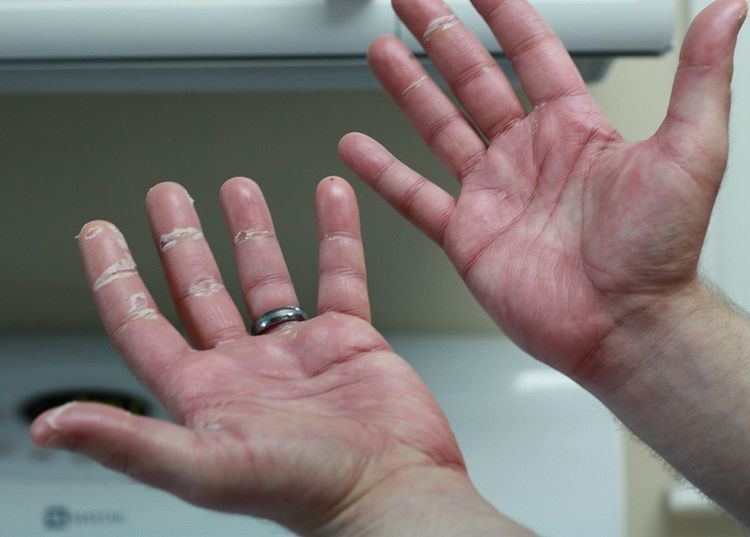ICD-10 Y43.1, Y43.3 DiseasesDB 34044 | ICD-9-CM 693.0, E933.1 | |
 | ||
Chemotherapy-induced acral erythema (also known as palmar-plantar erythrodysesthesia, palmoplantar erythrodysesthesia, or hand-foot syndrome) is reddening, swelling, numbness and desquamation (skin sloughing or peeling) on palms of the hands and soles of the feet (and, occasionally, on the knees, elbows, and elsewhere) that can occur after chemotherapy in patients with cancer. Hand-foot syndrome is also rarely seen in sickle-cell disease. These skin changes usually are well demarcated. Acral erythema typically disappears within a few weeks after discontinuation of the offending drug.
Contents
Synonyms
Synonyms for acral erythema (AE) include: hand-foot syndrome, palmar-plantar erythrodysesthesia, peculiar AE, chemotherapy-induced AE, toxic erythema of the palms and soles, palmar-plantar erythema, and Burgdorf’s reaction. Common abbreviations are HFS and PPE.
Signs and symptoms
The symptoms can occur anywhere between days to months after administration of the offending medication, depending on the dose and speed of administration (Baack and Burgdorf, 1991; Demirçay, 1997;). The patient first experiences tingling and/or numbness of the palms and soles that evolves into painful, symmetric, and well-demarcated swelling and red plaques. This is followed by peeling of the skin and resolution of the symptoms (Apisarnthanarax and Duvic 2003).
Causes
Acral erythema is a common adverse reaction to cytotoxic chemotherapy drugs, particularly Cabozantinib, cytarabine, doxorubicin, and fluorouracil and its prodrug capecitabine.
Targeted cancer therapies, especially the tyrosine kinase inhibitors sorafenib and sunitinib, have also been associated with a high incidence of acral erythema. However, acral erythema due to tyrosine kinase inhibitors seems to differ somewhat from acral erythema due to classic chemotherapy drugs.
Pathogenesis
The cause of PPE is unknown. Existing hypothesis are based on the fact that only the hands and feet are involved and posit the role of temperature differences, vascular anatomy, differences in the types of cells (rapidly dividing epidermal cells and eccrine glands).
In the case of PPE caused by PLD, the following mechanism has been demonstrated: sweat deposits and spreads the drug on the skin surface; then the drug penetrates into the stratum corneum like an external agent; palms and soles have high density of sweat glands, and their stratum corneum is approximately 10 times thicker than the rest of the body, and becomes an efficient long-term reservoir for the penetrating PLD, which was deposited on the skin before.
Diagnosis
Painful red swelling of the hands and feet in a patient receiving chemotherapy is usually enough to make the diagnosis. The problem can also arise in patients after bone marrow transplants, as the clinical and histologic features of PPE can be similar to cutaneous manifestations of acute (first 3 weeks) graft-versus-host disease. It is important to differentiate PPE, which is benign, from the more dangerous graft-versus-host disease. As time progresses, patients with graft-versus-host disease progress to have other body parts affected, while PPE is limited to hands and feet. Serial biopsies every 3 to 5 days can also be helpful in differentiating the two disorders (Crider et al., 1986).
Prevention
The cooling of hands and feet during chemotherapy may help prevent PPE (Baack and Burgdorf, 1991; Zimmerman et al., 1995). Support for this and a variety of other approaches to treat or prevent acral erythema comes from small clinical studies, although none has been proven in a randomised controlled clinical trial of sufficient size.
Treatment
The main treatment for acral erythema is discontinuation of the offending drug, and symptomatic treatment to provide analgesia, lessen edema, and prevent superinfection. However, the treatment for the underlying cancer of the patient must not be neglected. Often, the discontinued drug can be substituted with another cancer drug or cancer treatment.
Symptomatic treatment can include wound care, elevation, and pain medication. Corticosteroids and pyridoxine have also been used to relieve symptoms. Other studies do not support the conclusion. A number of additional remedies are listed in recent medical literature. Among them henna and 10% uridine ointment which went through clinical trial.
Prognosis
PPE invariably recurs with the resumption of chemotherapy. Long-term chemotherapy may also result in reversible palmoplantar keratoderma. Symptoms resolve 1–2 weeks after cessation of chemotherapy (Apisarnthanarax and Duvic 2003).
History
Hand-foot syndrome was first reported in association with chemotherapy by Zuehlke in 1974.
In Popular Culture
In season three, episode 8, titled "Sins of the Father," in the American television medical drama Private Practice, hand-foot syndrome is depicted, possibly inaccurately, in a patient. This episode first aired on November 19, 2009.
